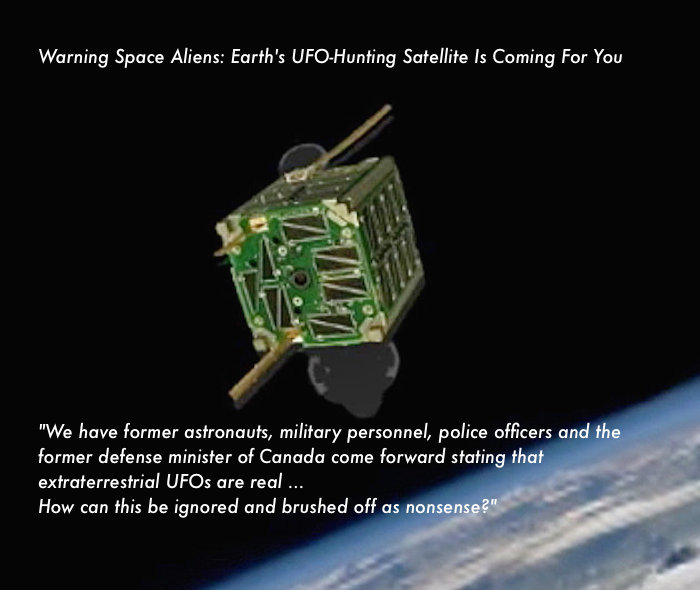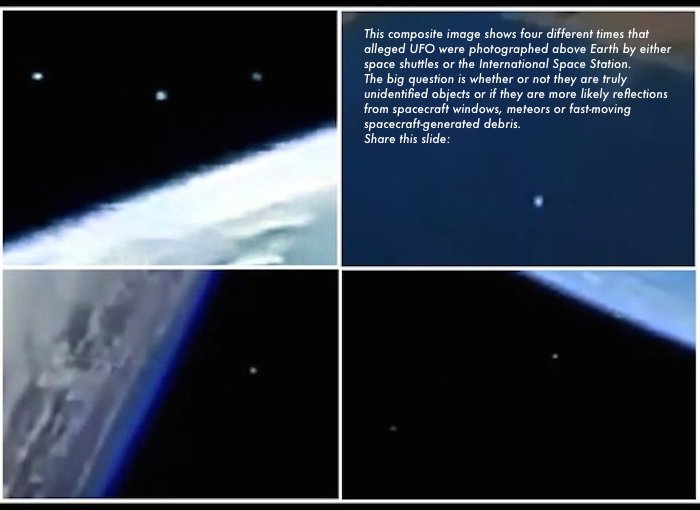.
Im Rahmen der Ufologen-Märchenstunden und Ignoranz von UFO-Aufnahmen im Orbit, welche auf ganz banale Dinge zurückzuführen sind, will man nun den UFO-Fans Geld aus der Tasche locken um einen CubeSat zu finanzieren. Dieser soll nun auf Alien-Jagd gehen und Beweise bringen "welche nicht zensiert sind" (wieder eine Märchenstunde). Stellt sich nur die Frage, wie weit man bei der Auswertung Weltraumschrott von etwaigen Alien-Raumschiffen unterscheiden kann und wir nicht wie seit Jahrzehnten "Lichtflecke" präsentiert bekommen die Alles sein können.
.

It seems like every day, a video or image emerges that appears to show a UFO near the International Space Station. And it generally -- OK, always -- turns out not to be a UFO. It's normally space debris, light reflections from the station windows, an antenna attached to the station, etc.
But wouldn't it be interesting if someone actually launched a satellite into Earth orbit (illustrated above), with the specific mission of trying to detect and prove unknown objects are actually out there?
Get ready for CubeSat for Disclosure, a team of researchers brought together by software engineer Dave Cote, who have a common purpose in launching their own satellite: To find and verify a real extraterrestrial craft.
"We have former astronauts, military personnel, police officers and the former defense minister of Canada come forward stating that extraterrestrial UFOs are real, and that we are being visited," Cote said in a press release. "How can this be ignored and brushed off as nonsense?"
On the following CubeSat for Disclosure video, Cote says his project "aims to use a low-orbit satellite controlled by us, the individuals, to study potential objects in our Earth's atmosphere."

"Maybe we'll get data readings and pictures of solar flared-caused auroras; maybe we'll capture images of some very interesting meteors; and maybe, we'll actually capture a verifiable craft. All we can do is try, and by doing this our way, we can open-source the data to you, the individuals," said Cote.
Current technology allows private citizens to build small, relatively affordable satellites, launch them into Earth orbit and perform various experiments. CubeSats are about the size of a shoebox, into which a variety of scientific equipment can be placed.
These nano-satellites can reach a height of around 195 miles above Earth for around $20,000, and have orbital lifespans of about three months before they burn up on re-entry.
For its UFO hunt, the CubeSat for Disclosure team will load the little satellite with infrared, electromagnetic and radiation sensors, as well as two cameras set to photograph a full 360 degrees.
"We control what the images are. We will have the images," said project coordinator Dave Shock. "If you're watching a live feed from the International Space Station, it can suddenly cut out and they'll say, 'Oh, we lost the signal.' But we will have total control of everything. Nobody will alter or corrupt our data so that the government can't cover up what we may find. This is all ours," Shock told The Huffington Post.
CubeSat for Disclosure doesn't have a launch date yet, and they're raising money to pack as much instrumentation into the satellite as possible.
"We're using the air and space port, Interorbital Systems, out of the Mojave Desert," Shock said. "We got the satellite through them and they'll do the launch. It's a whole package: You buy the satellite, you also get the launch. The more money we get, the more scientific equipment we can pack on board."
Quelle: The Huffington Post
.

Aufnahmen wie nachfolgend führen bei Hardcore Ufologen für klare Beweise für Raumschiffe über der Erde, welche unsere Astronauten beobachten würden, banale Erklärungen wie Eispartikel und Reflexionen werden standhaft ignoriert. Und so bilden sich Weltbilder über ein UFO-Phänomen welches es als solches so nicht gibt wie es die Märchenerzähler der UFO-Szene weiss machen wollen...
CENAP-Mannheim
4032 Views
